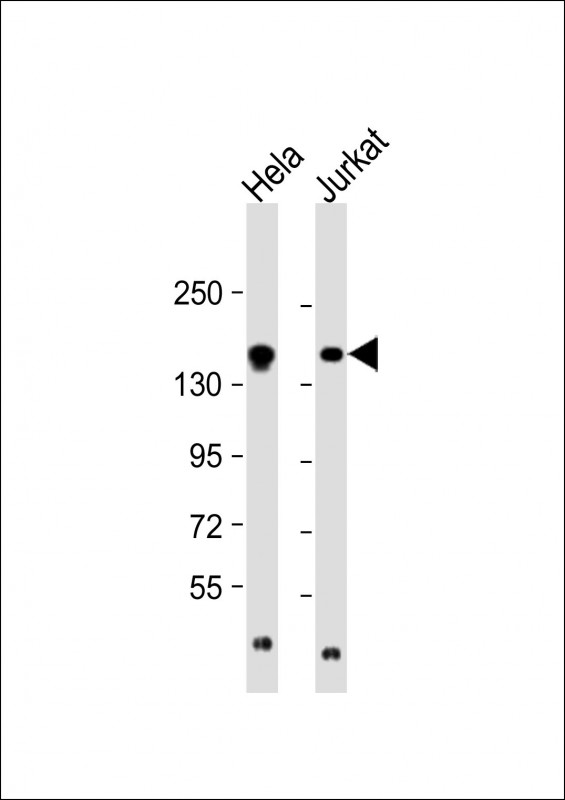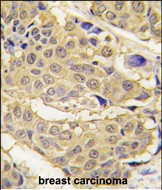EPRS Antibody (N-term)
Purified Rabbit Polyclonal Antibody (Pab)
- 产品详情
- 文献引用 : 1
- 实验流程
- 背景知识
Application
| IHC-P, WB, E |
|---|---|
| Primary Accession | P07814 |
| Reactivity | Human |
| Host | Rabbit |
| Clonality | Polyclonal |
| Isotype | Rabbit IgG |
| Calculated MW | 170591 Da |
| Antigen Region | 285-314 aa |
| Gene ID | 2058 |
|---|---|
| Other Names | Bifunctional glutamate/proline--tRNA ligase, Bifunctional aminoacyl-tRNA synthetase, Cell proliferation-inducing gene 32 protein, Glutamatyl-prolyl-tRNA synthetase, Glutamate--tRNA ligase, Glutamyl-tRNA synthetase, GluRS, Proline--tRNA ligase, Prolyl-tRNA synthetase, EPRS, GLNS, PARS, QARS, QPRS |
| Target/Specificity | This EPRS antibody is generated from rabbits immunized with a KLH conjugated synthetic peptide between 285-314 amino acids from the N-terminal region of human EPRS. |
| Dilution | IHC-P~~1:100~500 WB~~1:8000 E~~Use at an assay dependent concentration. |
| Format | Purified polyclonal antibody supplied in PBS with 0.09% (W/V) sodium azide. This antibody is prepared by Saturated Ammonium Sulfate (SAS) precipitation followed by dialysis against PBS. |
| Storage | Maintain refrigerated at 2-8°C for up to 2 weeks. For long term storage store at -20°C in small aliquots to prevent freeze-thaw cycles. |
| Precautions | EPRS Antibody (N-term) is for research use only and not for use in diagnostic or therapeutic procedures. |
| Name | EPRS1 (HGNC:3418) |
|---|---|
| Function | Multifunctional protein which primarily functions within the aminoacyl-tRNA synthetase multienzyme complex, also known as multisynthetase complex. Within the complex it catalyzes the attachment of both L-glutamate and L-proline to their cognate tRNAs in a two-step reaction where the amino acid is first activated by ATP to form a covalent intermediate with AMP. Subsequently, the activated amino acid is transferred to the acceptor end of the cognate tRNA to form L- glutamyl-tRNA(Glu) and L-prolyl-tRNA(Pro) (PubMed:23263184, PubMed:24100331, PubMed:29576217, PubMed:3290852, PubMed:37212275). Upon interferon-gamma stimulation, EPRS1 undergoes phosphorylation, causing its dissociation from the aminoacyl-tRNA synthetase multienzyme complex. It is recruited to form the GAIT complex, which binds to stem loop-containing GAIT elements found in the 3'-UTR of various inflammatory mRNAs, such as ceruloplasmin. The GAIT complex inhibits the translation of these mRNAs, allowing interferon-gamma to redirect the function of EPRS1 from protein synthesis to translation inhibition in specific cell contexts (PubMed:15479637, PubMed:23071094). Furthermore, it can function as a downstream effector in the mTORC1 signaling pathway, by promoting the translocation of SLC27A1 from the cytoplasm to the plasma membrane where it mediates the uptake of long- chain fatty acid by adipocytes. Thereby, EPRS1 also plays a role in fat metabolism and more indirectly influences lifespan (PubMed:28178239). |
| Cellular Location | Cytoplasm, cytosol. Membrane; Peripheral membrane protein Note=Translocates from cytosol to membranes upon phosphorylation at Ser-999. |
For Research Use Only. Not For Use In Diagnostic Procedures.

Provided below are standard protocols that you may find useful for product applications.
BACKGROUND
Aminoacyl-tRNA synthetases are a class of enzymes that charge tRNAs with their cognate amino acids. EPRS is a multifunctional aminoacyl-tRNA synthetase that catalyzes the aminoacylation of glutamic acid and proline tRNA species.
REFERENCES
Jia,J., Mol. Cell 29 (6), 679-690 (2008)
Beausoleil,S.A., Nat. Biotechnol. 24 (10), 1285-1292 (2006)
Kato,T., Cancer Res. 65 (13), 5638-5646 (2005)
Sampath,P., Cell 119 (2), 195-208 (2004)
终于等到您。ABCEPTA(百远生物)抗体产品。
点击下方“我要评价 ”按钮提交您的反馈信息,您的反馈和评价是我们最宝贵的财富之一,
我们将在1-3个工作日内处理您的反馈信息。
如有疑问,联系:0512-88856768 tech-china@abcepta.com.






















 癌症的基本特征包括细胞增殖、血管生成、迁移、凋亡逃避机制和细胞永生等。找到癌症发生过程中这些通路的关键标记物和对应的抗体用于检测至关重要。
癌症的基本特征包括细胞增殖、血管生成、迁移、凋亡逃避机制和细胞永生等。找到癌症发生过程中这些通路的关键标记物和对应的抗体用于检测至关重要。 为您推荐一个泛素化位点预测神器——泛素化分析工具,可以为您的蛋白的泛素化位点作出预测和评分。
为您推荐一个泛素化位点预测神器——泛素化分析工具,可以为您的蛋白的泛素化位点作出预测和评分。 细胞自噬受体图形绘图工具为你的蛋白的细胞受体结合位点作出预测和评分,识别结合到自噬通路中的蛋白是非常重要的,便于让我们理解自噬在正常生理、病理过程中的作用,如发育、细胞分化、神经退化性疾病、压力条件下、感染和癌症。
细胞自噬受体图形绘图工具为你的蛋白的细胞受体结合位点作出预测和评分,识别结合到自噬通路中的蛋白是非常重要的,便于让我们理解自噬在正常生理、病理过程中的作用,如发育、细胞分化、神经退化性疾病、压力条件下、感染和癌症。







